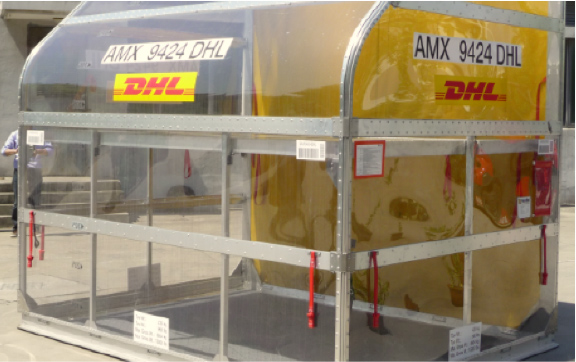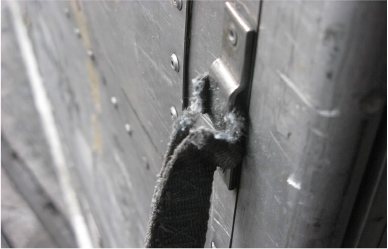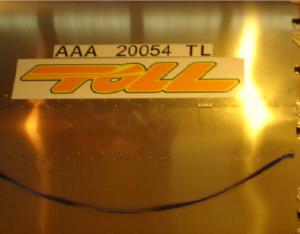Cargo Terminals, Freight Forwarders, CARE, Ground Handlers, Continuing Airworthiness, ULD Service providers
ULD and Pull Straps
You are highly unlikely to see any kind of air cargo container that is not equipped with some kind of pull straps. Given that these are physically small items they do not often draw a great deal of attention however there are some quite important considerations that need to be kept in view when it comes to these pull straps.
 The primary function of the pull strap is to provide ground handling staff with a device to enable them to move a container around through simple manpower. ULD are designed to be supported and to move around on roller systems or ball mat systems, and so even when fully loaded they should not require a great deal of force to overcome any kind of rolling resistance.
The primary function of the pull strap is to provide ground handling staff with a device to enable them to move a container around through simple manpower. ULD are designed to be supported and to move around on roller systems or ball mat systems, and so even when fully loaded they should not require a great deal of force to overcome any kind of rolling resistance.
The IATA standard for any kind of container (SS 50/4 in the IATA ULD Regulations Manual) states that “two flush handles or straps should be located on each side panel for manual movement of the container. Each handle should provide space suitable for gripping with a gloved hand and shall have capacity of 445 daN (1000lb) pull in any direction”
This requirement places the responsibility on the ULD manufacturer to ensure that a suitable number of straps of a suitable strength are attached using an attachment system also capable of meeting the strength requirements, and it is probably quite safe to say that every single ULD that leaves a ULD manufacturers facility does meet this requirement.
However, taking a walk around a typical cargo terminal or other facility utilizing ULDs can tell a very different story. Basically it all comes down to there being 2 types of failings around ULD pull straps.
1. The first is when some kind of non-manual force is applied to the hand strap, perhaps through the use of an additional piece of rope or other mechanism that is used to connect the container to a mechanical force such as a tractor. This is the sort of process that can occur when a ground handling operation tries to pull a loaded container across a concrete floor. Such an activity will far exceed the capacity of human manpower, and will require that a force greatly in excess of 1000lb be exerted on the strap. The best outcome in such a case is that the strap or its attachment simply breaks but quite often what may occur is that they do not fail completely but are simply damaged, setting the scene for failure at a future time and at a lower load.
additional piece of rope or other mechanism that is used to connect the container to a mechanical force such as a tractor. This is the sort of process that can occur when a ground handling operation tries to pull a loaded container across a concrete floor. Such an activity will far exceed the capacity of human manpower, and will require that a force greatly in excess of 1000lb be exerted on the strap. The best outcome in such a case is that the strap or its attachment simply breaks but quite often what may occur is that they do not fail completely but are simply damaged, setting the scene for failure at a future time and at a lower load.
2. The second failing is where straps are simply damaged through normal operational wear and tear, banging up against other containers or other airport infrastructure. In such cases the webbing and/or the attachment hardware can be degraded to the point that their capacity is far below the 1000lb requirement.
Both these conditions should raise an extreme alert with anybody having any concern regarding health and safety. The probability of a serious fall should one of these straps fail during use is extremely high. Over the years, there have been more than one fatal accidents involving people falling backwards off high loaders when a pull strap fails suddenly during use.
The IATA Operational Damage Limits Notice which has for some years now been fitted to all new ULD and can be widely found states clearly

that there should be no kind of damaged worn out or missing pull straps. As it is a requirement for every container to be inspected before use and as it can hardly be said to be difficult to determine the condition of the pull straps, there should be absolutely no excuse for any ULD to be in operation with a strap that is not 100% serviceable. Of course, there will always be the temptation to let a container go through if the strap is found to be damaged after the container has been loaded. This of course can never be condoned and it highlights the absolute importance of inspecting not only the pull straps but the entire container before even the first step of th e loading process takes place.
e loading process takes place.
On some large containers, particularly those utilized in aircraft not equipped with powered cargo loading systems and which therefore may require the use of more manpower to move them along the aircraft, the ULD may be equipped with a longer side to side strap as shown here. Although it might appear tempting to utilise such a strap together with some kind of mechanical device such as a tow tractor or forklift, this would be absolutely incorrect, as this strap is only designed for manual operation, having a capacity of 1000 lbs.
In closing this article, it is worth having a short discussion on the design of hand straps. By far the safest design of hand strap has no kind of loop provision; in other words, it is impossible for the operator to place their entire hand through a loop in the strap. This is because such an action can trap the operator in a situation where they could be dragged along should the ULD be moved. Operators may feel that they can exert more force on the container if the strap is in the form of a loop but the reality is that as long as the ULD is supported on the proper ground support equipment, there is no need to ever provide additional force. It should be perfectly easy to move the ULD by simply holding the strap with one hand and pulling with normal force.
ULD pull straps are potential source of extreme risk, they may be small and they may appear insignificant but this should never be an excuse for them to be used improperly or used in anything other than a fully serviceable condition.



Comments are closed.